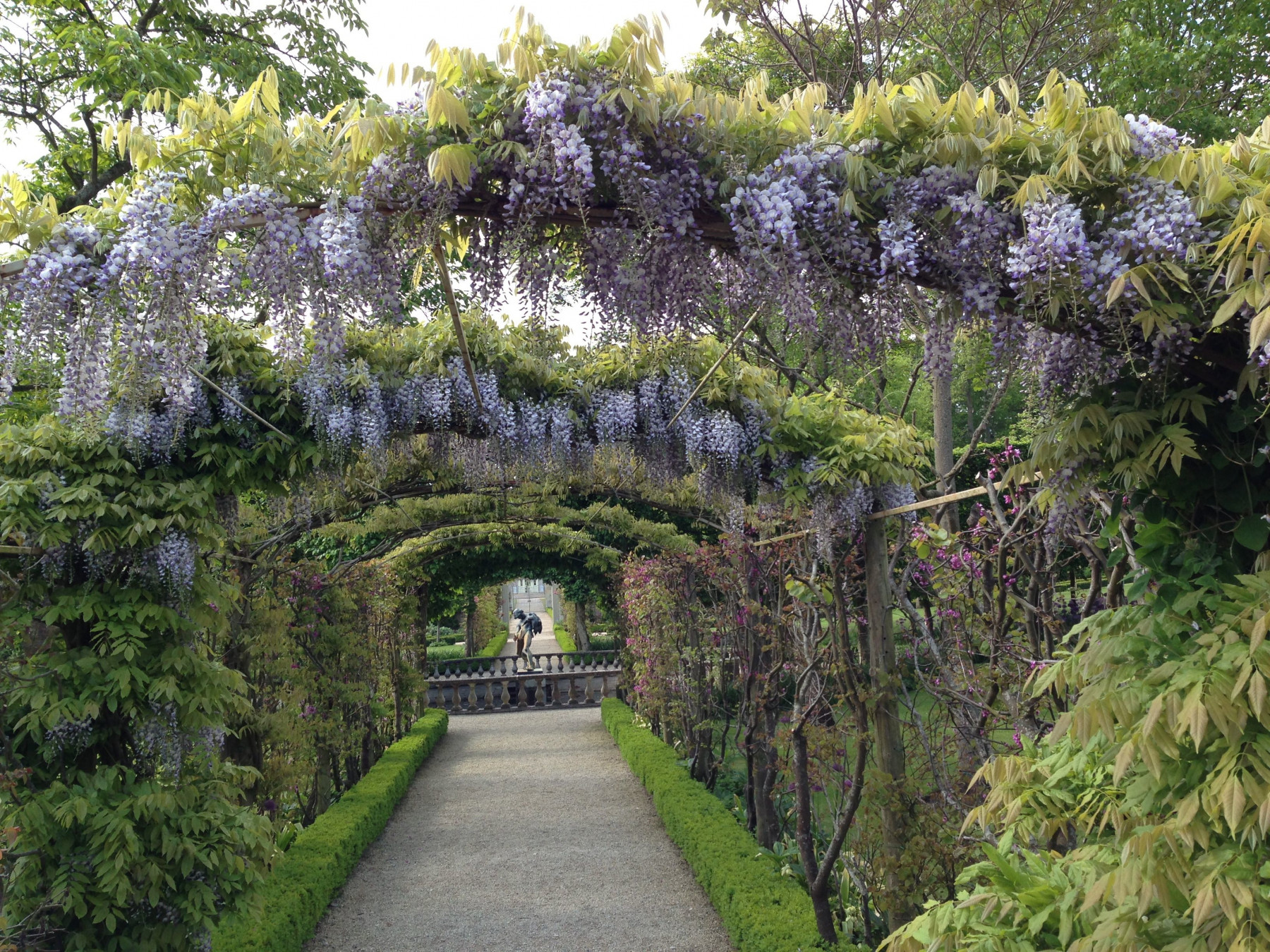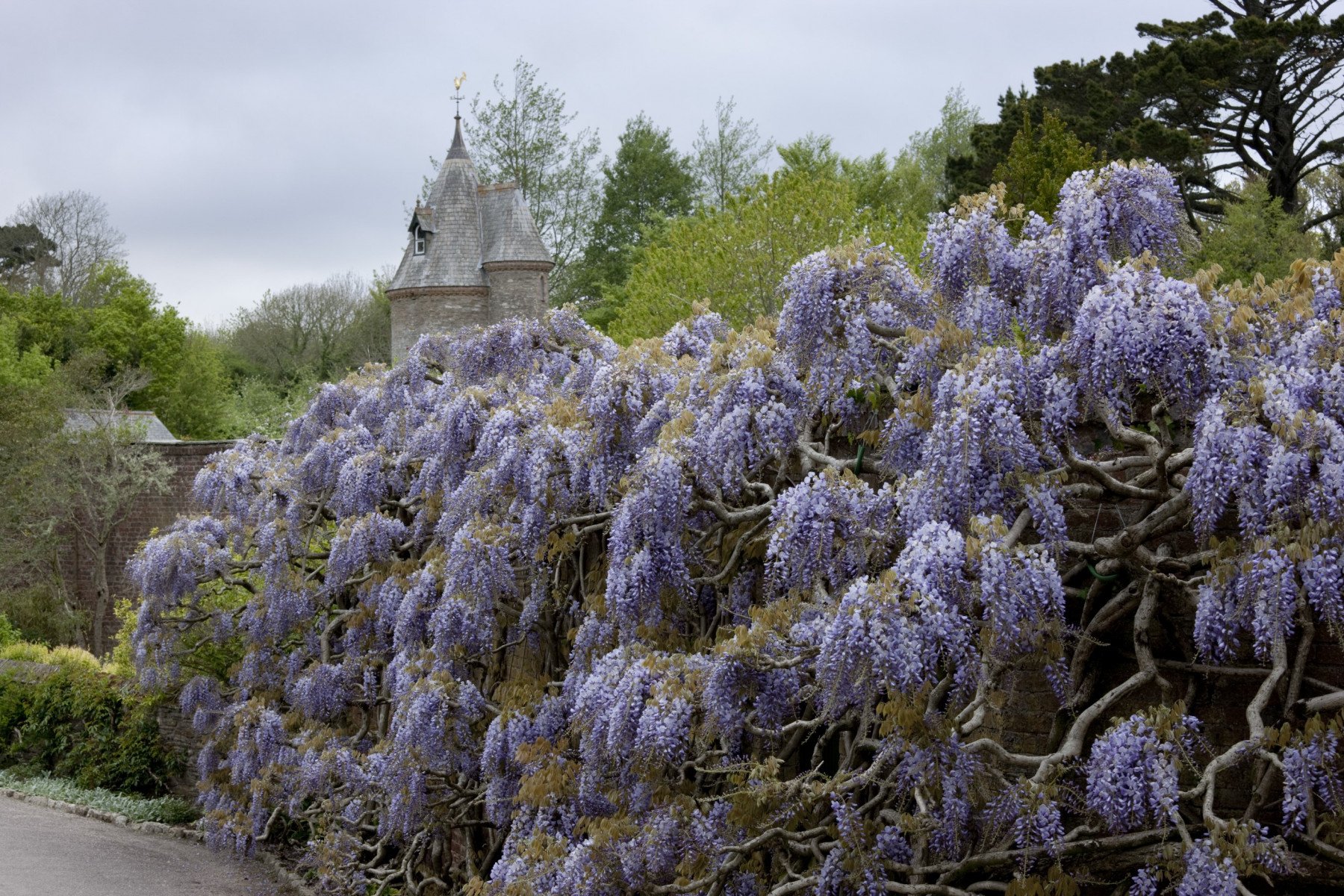
I always get wisteria envy at this time of year, because it’s one climber I don’t seem to be able to find the right place for. I’ve planted two in my lifetime and the first one was in a Northamptonshire garden in the late 1980s. I recently went back for a peek and it’s now an enormous plant, although sadly I left Rose Cottage when it was still tiny. The Akebia quinata, also tiny when I left, is covering the south front of the house and the rambling rose, the name long forgotten, completes the trio.
I planted another wisteria in another garden twenty years ago that’s also pretty large now too. However Spring Cottage is so old it hasn’t got proper foundations and I’m not allowed to add a potential triffid that might cause problems long after I’m gone. Instead I’m forced to stand and stare and I often deviate to see a magnificent wisteria en route to somewhere or other. Sometimes I’m known to get out of the car because wisterias can be extremely fragrant so this is one plant you really do need to buy in flower. They’re expensive, because they’re grafted, but this allows them to flower when they’re younger. Choose one with a good colour and a good fragrance, and then stand back and wait.
There’s one in the village of Bloxham near Banbury, festooning a house close to the Village Hall, and it’s given me decades of pleasure. Like all wisterias it’s magnificent this year, egged on by last year’s fantastic summer. If planting close to a wall, you must make sure that it’s a metre away. Once your wisteria reaches your desired height, begin tying the shoots in to form leaders and laterals.
The wisteria at Bloxham gets a two-stage pruning regime and this requires a long ladder and a head for heights. The long whippy growth, which reaches a foot in length by July, should be cut back to four to six leaves towards the ripened wood. The second prune occurs when this climber is just stirring, in February or early March. Leave two buds on each shoot to create a skeletal framework. This twice-yearly pruning regime lets in more light and ripens the wood, encouraging more flowering spurs and fatter flower buds. This twice yearly prune will also keep wisterias compact making them less prone to wind damage should gales occur. Watch the sap when pruning, it stains your clothing a rusty brown. If you’re rejuvenating an old wisteria, tackle it in February or early March.
Wisterias live for a very long time and the oldest one I know straddles the old White Lion pub in Banbury, curling round a black circular staircase. The way they climb has made them a garden favourite for walls, pergolas and arches. One of the more useful bits of horticultural knowledge I learnt from my grandmother is the difference in the way they twine. Chinese wisterias (labelled W. sinensis) and Japanese (labelled W. floribunda) twine in different directions. A simple way of remembering is to form the letter C with your finger staring at the top. This clockwise movement describes the way Chinese wisterias ( W. sinensis) twine. Now make a J starting from the top and your finger will move in anticlockwise direction – the same way the Japanese wisterias ( W. floribunda) twine. Another way of telling is that W. sinensis produces its flowers on bare wood, whilst W. floribunda has leaves and flowers at the same time.
The name Wisteria is a botanical typo, because they’re named after Caspar Wistar (1761 – 1818), a professor of anatomy at the University of Pennsylvania, so pedants would claim that it should really be Wistaria. There are ten species found in China, Japan and the Eastern USA and in the wild they are often found close to streams, near wet woodlands and close to damp cliffs. There are lots of genera that have a foothold in Asia and America because this was once one land mass. Continental drift saw these two separate into two. Some evolved in Asia and others in North America and generally it’s the Asian plants that are the most exciting.

Wisteria enjoy a warm site that gets plenty of summer rain, because this reminds them of home. A west-facing wall is often cited as the best, although many inhabit warmer more-southerly walls in London. There is a particularly fine clone in Holland Park which I try to visit in wisteria time, if I can. The one direction to avoid is east-facing because a late frost ,followed by early morning quick thaw, ruptures the cells. Camellias and magnolias will suffer the same fate. A magnificent, elderly specimen of wisteria, growing on the tithe barn at Sudeley Castle near Winchcombe in Gloucestershire, succumbed some twenty years ago at the hands of a very late frost.
There’s been a recent wisteria trial at RHS Wisley, held between 2008 and 2012. The Award of Garden Merit, or AGM, was given to the best and this is usually put on plant labels. It sometimes depicted as a trophy shape. Winners included W. sinensis ‘Prolific’, a violet-blue, anticlockwise twiner with a good scent. This can produce bean-like seed pods, but probably not in Cold Aston! ‘Amethyst’, another anticlockwise twiner, has denser racemes in a paler colour. If you want something that has long dangling flowers, ‘Burford’ has bi-coloured flowers in lilac and purple. Equally long, if not longer flowers, are produced by W. brachybotrys ‘Okayama’. White wisterias brown badly due to a lack of pigment in the petals. They’re probably best avoided.
These newer wisterias are becoming far more available. Many are propagated by Chris Lane, a wholesale nurseryman who holds a Plant Heritage Collection in Kent. He doesn’t open to the public, but there’s a Wisteria Open Day on Sunday 12th May, between 10.00am and 2.00 pm. Entrance costs a £5 donation to Demelza House and includes a hot drink, cake and guided tour of collection. See www.witchhazelnursery.com for more information.



